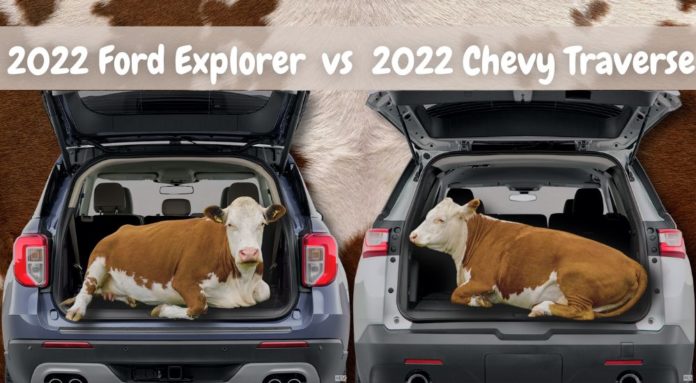Friends, if you’re anything like me, you won’t buy a vehicle – or even take it for a test drive – without doing a tremendous amount of research about it first. There’s no reason to waste your time or money on a car, truck, or SUV that can’t do what you need it to. When I’m shopping for a car, I like to really look at what it has to offer and also compare it to other models to see how well they stack up. If I was looking for a large, three-row SUV, for example, I’d compare the 2022 Ford Explorer vs 2022 Chevy Traverse to see which one has what I need.
Now I’m not talking about taking a look at engines and power – those things are important, but they’re just a jumping-off point. No, when you’re comparing vehicles and doing research to figure out which SUV has what you’ve been looking for, you need to think about your daily routine, the errands you run, the passengers you need to transport, and the kinds of cargo that you’ll want to be able to lug about on a routine basis. And if you’re anything like me, and I’m sure you are, then that means one thing: tongues!
Cargo Requirements for Cow Tongues
We’ll start off with what you probably have to transport the most: cow tongues, which we all know are absolutely delicious when prepared and cooked properly. I’m not going to share my favorite recipe right now, partly because we don’t have the time and partly because that’s none of your damn business. But I know that what I’m looking for is a vehicle that can transport a lot of tongues – I don’t want to be making multiple trips every week to get all my tongues home. Who has time for that?
In general, cow tongues weigh about 3 to 4 lbs and measure somewhere around 12 inches in length and 3 inches wide – to keep things simple, we’ll go with a weight of 3.5 lbs for a simple average. I use the standard Norwegian stack-and-pack technique for transporting my cow tongues, which means bundling and strapping them together in simple, one-foot cubes with 16 tongues per cube and each cube weighing about 56 lbs – we’ll ignore the added weight of the straps since we’re using averages anyways and assume the numbers all work out.
So, with this in mind, how do these two SUVs compare?
The Ford Explorer vs. Chevy Traverse
If you’re just looking to load-up tongues into the rear of the vehicle, either because you’re some kind of amateur or you need to have five or six people along with you when you transport your tongues, then you’ll want to focus on just the rear storage area. The Explorer offers 18.2 cu.ft. of rear cargo space, while the Chevy Traverse has 23 cu.ft. of space. In other words, you can get just 18 of our cow-tongue cubes loaded into the rear of the Explorer, while as many as 23 cubes or more than 300 tongues can fit into the roomy back-end of the Traverse.
I’ll assume you have greater tongue needs than that, however, and you’ll want to really explore the lickable space of your SUV. Behind the second row of seats, the Ford Explorer has about 48 cu.ft. of space, while the Traverse has more than 57 cu.ft. of cargo room. Behind the rear seats, the Explorer tops out at about 87 cu.ft., while the Traverse can hold up to 98 cu.ft.. In other words, you may be able to fit 11 more tongue cubes – that’s 176 tongues in total – behind the front seat of the Chevy model! The one advantage the Ford model has, however, is the 600 lbs of additional towing capacity compared to the Chevy. So if you want to load up a trailer full of tongues, then you may be able to transport about 10 more cubes in terms of total weight.
More Refined Tastes
I’m not here to judge, so I’ll provide the following information devoid of context. The human tongue measures about 4 inches in length, about 2 inches wide, and maybe an inch tall – meaning you can get about 216 human tongues packed into a cubic foot. Or, in other words, you can fit well over 2,000 more human tongues into the cargo area behind the front row of seats in the Chevy Traverse compared to the Ford Explorer. Now that sounds like a good time!
Editor’s Note: Finally, some useful information – it would be convenient to be able to transport more than 1,500 cow tongues at once – some of us at the office are getting sick and tired of making seven, sometimes a dozen, trips to the tongue market every single week. But would the savings in gas make up for the extra cost of a new, three-row SUV? We’ll have to consider this and let you know. Thank you.












